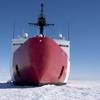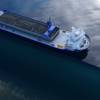From the Department of Defense
The Navy announced Jan. 16 that two important steps have been taken under existing law and regulations to allow it to conduct effective, integrated training with sonar off the coast of southern California after a federal court earlier this month imposed untenable restrictions on such training.
In accordance with the provisions of the Coastal Zone Management Act (CZMA), and at the recommendation of the Secretary of Commerce, President George W. Bush concluded that continuing these vital exercises without the restrictions imposed by the district court is in the paramount interests of the United States. He signed an exemption from the requirements of the CZMA for the Navy's continued use of mid-frequency active sonar in a series of exercises scheduled to take place off the coast of California through January 2009. The Navy already applies 29 mitigation measures approved by federal environmental regulators when using active sonar, and these will remain in place.
An exemption from the act was sought after an order was issued on Jan. 3 by the U.S. District Court for the Central District of California, which created a significant and unreasonable risk that the Navy will not be able to conduct effective sonar training necessary to certify strike groups for deployment in support of world-wide operational and combat activities.
Use of sonar is part of critical, integrated training that must be done in the Navy's operating area off the coast of San Diego to take advantage of Southern California's bathymetric features and its extensive ranges, airfields and other infrastructure necessary for effective training. Approximately half the Navy's fleet will receive its most critical, "graduate level" training here before it deploys its forces around the world.
In a separate but related action, the Council on Environmental Quality approved the Navy's request for alternative arrangements for compliance with the National Environmental Policy Act, or NEPA, for these exercises until completion of the Southern California Range Complex environmental impact statement.
Following up on these actions, Secretary of the Navy Donald C. Winter signed a decision memorandum Jan. 15 agreeing to those arrangements, which include adaptive management measures, more thorough reporting procedures and increased public participation.
"We can protect our national security while simultaneously being good stewards of the environment," said Winter. "These alternative measures, in addition to the 29 protective measures already in place, will ensure our operating forces can train realistically without harming the environment.
"We are already taking extensive measures to protect marine mammals, and we have had positive results from those measures," said Winter. "We are furthermore committed to an extensive data collection effort to help inform our future efforts in this regard."
Even before the court's order, the Navy employed 29 protective measures, developed in cooperation with the National Marine Fisheries Service, any time sonar is used on Navy ranges, or in major exercises. The existing measures include, among other things, stationing specially trained lookouts to look for marine mammals, passive acoustic monitoring for marine mammals, establishing safety zones around ships where sonar power is reduced or shut down if marine mammals are sighted and employing extra precautions during chokepoint exercises.
Chief of Naval Operations Adm. Gary Roughead said that the actions were necessary in order to ensure the Navy's ability to train Sailors to detect quiet submarines that might threaten its ships.
"We cannot in good conscience send American men and women into potential trouble spots without adequate training to defend themselves," said Roughead.
"The southern California operating area provides unique training opportunities that are vital to preparing our forces, and the planned exercises cannot be postponed without impacting national security," said Roughead. "The steps that have been taken will allow our men and women to train realistically, while continuing the effective employment of proven mitigation measures that have been endorsed by the Council on Environmental Quality and our regulator, the National Marine Fisheries Service."
Featured videos

Inmarsat Enhances Service to Drive Digitalization

Tracking Foreign Vessels Working in the U.S. Jones Act Market

Inside the Electrified Truckable Tug
Subscribe for
Maritime Reporter E-News
Maritime Reporter E-News is the maritime industry's largest circulation and most authoritative ENews Service, delivered to your Email five times per week









